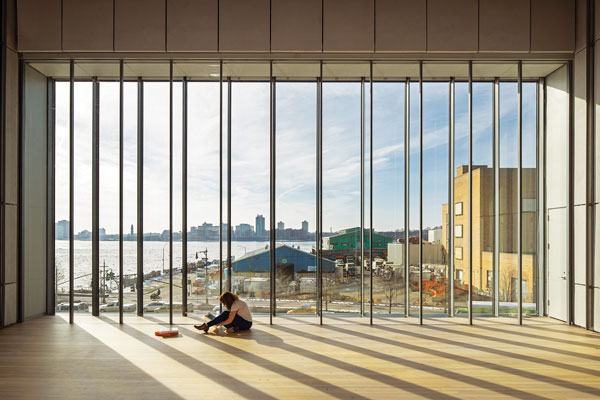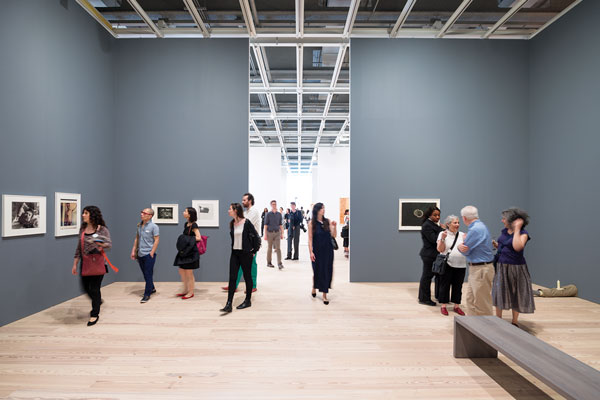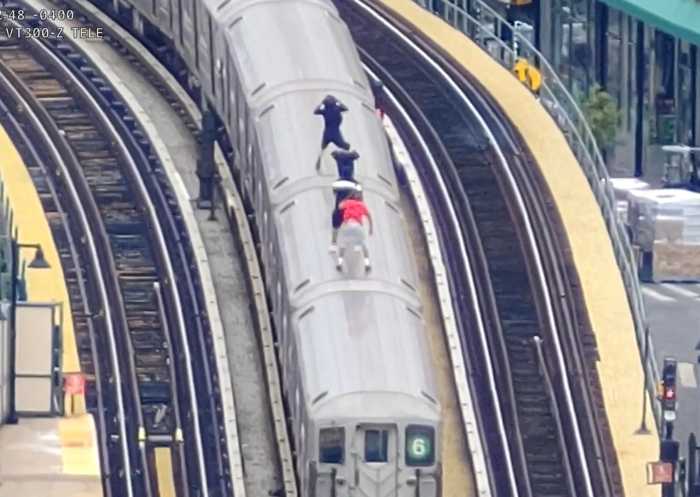
The Whitney establishes itself as a good neighbor by throwing a free Block Party on May 2, 10:30 a.m.–10 p.m. in front of its 99 Gansevoort St. location.
BY STEPHANIE BUHMANN | On May 1, the Whitney Museum of American Art will open its newly Renzo Piano-designed home to the public. That night, the Empire State Building will light up in its honor by re-interpreting 12 iconic works from the Whitney collection by Georgia O’Keeffe, Edward Hopper, Andy Warhol and others.

It will seem as if the whole city is celebrating — and the opening certainly has the potential to become New York’s most important cultural event of the decade. However, it will also mark the beginning of a fresh chapter in the Whitney’s history, and not simply a geographical one. Considering its new location, impressive architecture and upcoming programming, the Whitney has embarked on a major identity overhaul, readying itself for a future of growth.

In contrast to the Whitney’s previous Upper East Side location at 75th St. & Madison Ave. (1966-2014), its new neighborhood is infinitely more youthful and tourist-laden. It also happens to be closer to its original address on West Eighth St. in Greenwich Village, where Gertrude Vanderbilt Whitney founded it in 1931.

While on the Upper East Side, the Whitney was mere walking distance from other major museums, such as The Metropolitan Museum of Art, the Neue Galerie, the Frick Collection and the Guggenheim Museum, among others.
Now, it stands proudly alone. However, situated at the southern tip of the High Line and within the buzzing Meatpacking District, the Whitney is part of a much more lively scene. It is only steps away from the Standard Hotel, the Gansevoort Hotel, the Headquarters of Diane von Furstenberg, the Chelsea Market, Google, an Apple Store and countless boutiques, fashionable restaurants, bars and clubs.
Along these lines, on May 2, the Whitney Block Party (Gansevoort St., in front of the museum, 10:30 a.m.–10 p.m.) will embrace this neighborhood’s youthful spirit. Sponsored by Macy’s, just like the beloved Thanksgiving Parade and 4th of July Fireworks, this party intends to welcome visitors of all ages with free art and performances. It is further proof of the Whitney’s strong desire to embrace its new location wholeheartedly, while making its architecture a vivid experience for all.

No matter how much immediate attention will be focused on the surrounding events and the Museum’s elegant outer appearance, stunning improvements are to be found on the inside. Certainly, Piano’s boat-like vision of a building deserves ample contemplation. It pays splendid homage to the Hudson River and the history of Chelsea Piers, where in the early 20th century, most major trans-Atlantic liners docked and survivors of the Titanic disembarked. It also respectfully nods to the Frank Gehry-designed IAC building just a few blocks north, whose form is also inspired by ships.

Nevertheless, the Whitney’s inaugural exhibition “America Is Hard to See” (May 1–Sept. 27, 2015), whose fantastic title was taken from a Robert Frost poem, is certainly capable of drawing its own significant attention. It is organized by a whole team of Whitney curators, led by Donna De Salvo, Chief Curator and Deputy Director for Programs, including Carter E. Foster, Curator of Drawing; Dana Miller, Curator of the Permanent Collection; and Scott Rothkopf, Family Curator and Associate Director of Programs; with Jane Panetta, Assistant Curator; Catherine Taft, Assistant Curator; and Mia Curran, Curatorial Assistant.
Spanning several floors, “America is Hard to See” celebrates the Whitney’s acclaimed permanent collection in an unprecedented way. No less than 600 works by 400 artists fill up the significantly expanded 50,000 square feet of gallery space and 13,000 square feet of terraces.

The show marks the Whitney’s most ambitious presentation of and in-house reflection on its acclaimed collection, which spans from about about 1900 to the present. “America is Hard to See” is organized chronologically with the eighth and highest floor featuring the oldest work.
The exhibit is also organized thematically, however. Themes are introduced as chapters, and there are 23 total. Bringing together related artworks, each is named after a work that appears in that particular section of the show. This makes for an incredibly extensive but well-structured, and therefore manageable, survey of the many different ideas, beliefs, and passions that have preoccupied American artists during the past 115 years.
For those well familiar with the Museum’s collection, “America is Hard to See” holds many surprising treats. Artists rarely featured and works that have never been exhibited before are seamlessly merged with beloved icons. On the eighth floor, for example, the impact of the Industrial Revolution and urban innovation loom large. Here, one of the themes explored is titled “Machine as Ornament” and various depictions of the Chrysler Building help to illustrate an era when machines and technological advances were viewed with romantic enthusiasm. Floors seven and six present works from the mid-20th century, while five, the building’s largest and column-free space, covers the late 1960s to the present.
Throughout the different floors, it is a pleasure to follow the detailed curation of the installation. There are plenty of witty pairings to be found, such as George Tooker’s “The Subway” from 1950 and Edward Hopper’s “Early Sunday Morning” from 1930. Though different in style and aesthetic, both paintings fit thematically, as well as compositionally. Both of these compositions are rooted in strong vertical lines that, not unlike prison bars, succeed in stressing an overall sense of isolation. Some chapters thrive thematically but feel somewhat cramped. One entitled “Scotch Tape,” for example, features artists, who worked with non-traditional materials. Robert Rauschenberg, Louise Nevelson, Lee Bontecou and Jay DeFeo, are among those presented here. However, these works rank among the most complex and significant in the Museum’s collection and finding them so closely installed to each other seems like overkill. In fact, they begin to cancel each other out.
In contrast to the old Marcel Breuer building, which to me personally always felt like entering dark catacombs, the new galleries couldn’t feel lighter. Each floor features large windows and the eighth floor has some of the best skylights in town (including an elaborate shading system). Meanwhile, spaces are simple and to the point; they are functional and ready to vanish behind the works of art they are supposed to feature. The ceiling shows an elaborate grid of tracks, from which movable hanging walls can be configured freely. It is clear that Piano’s galleries are supposed to move for, and in the name of, art. It is a nice surprise, because too often museum architecture seems to defy its main purpose: to showcase the art housed inside.
Other much-welcomed features include a theater-performance space on the third floor, something the Whitney has lacked thus far. On May 16, a major documentary on the legendary Eva Hesse will premiere here in the context of a private event. The fact that the new theater also features a window with a scenic view of the Hudson River makes it especially enticing. Here, Piano, who might have taken inspiration from Jazz at Lincoln Center at the Time Warner Center, whose characteristic feature is a monumental view of Central Park, has made sure that the Whitney now owns one of the most sought after event spaces in the city — for their own purposes and luxurious private functions.
Overall, the Whitney seems to strive for a new sense of openness that goes with its new youthful location. This is reflected in its fresh contemplation of its permanent collection, as well as in the architecture, which fuses art and cityscapes throughout. Terraces enable visitors to leave the museum temporarily to rest and soak in the stunning textures of the neighborhood. In addition, higher floors also allow for views into offices and storage rooms.
There is something democratic about this transparency. The new version of the Whitney is no longer a dark temple for art, but rather a continuously morphing cloud, on which art hovers just above the city. It remains a wonderful space to view modern art, but for the first time, the Whitney is a fantastic museum to view contemporary work. This will certainly aid the reputation of the Whitney Biennial (spring 2017) and assure interest of a younger generation of artists.
Looking at the advance exhibition schedule, it becomes clear that there will be room for both prominent names, such as Frank Stella, whose retrospective will run from Oct. 30–Feb. 7, 2016, as well as the emerging ones, including Jared Madere, Rachel Rose and Sophia Al-Maria.
There remains plenty to discover no doubt. I personally look forward to returning one evening in the near future, specifically to visit Edward Hopper’s “Railroad Sunset.” This well-known masterpiece can be found on the seventh floor, installed right across a major window facing the Hudson. It promises to be an epic battle of the city’s two most stunning sunsets.
The Whitney Museum of American Art is located at 99 Gansevoort St. (btw. 10th Ave. & Washington St.). Call 212-570-3600 or visit whitney.org.
































